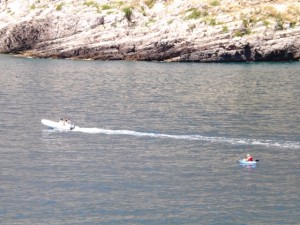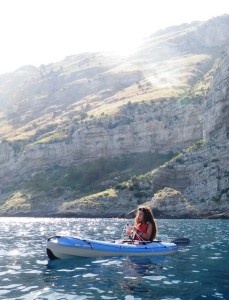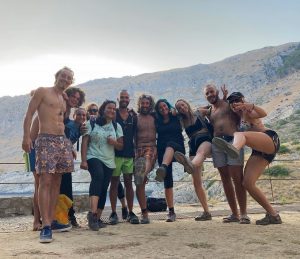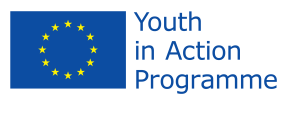The busy tourist season had just started at the end of June, and along with it, a new aspect of our work: the monitoring of the Ieranto Bay and the management of the Infopoint. We all take turns, so everybody is involved in this multifaceted task.
The monitoring consists of informing sailors about why this bay is protected, what we do, and giving away documentation about the Marine Protected Area of Punta Campanella in general. We also explain to motorboat users and fishermen that those activities are forbidden in the Ieranto Bay but allowed in other parts of the sea. We are lucky because most of them understand that it is very important to protect this amazing place, and applaud our initiative. I can’t speak about the whole group, but the most common reaction when people see me is to smile.
You must imagine the scene though. I’m usually in a red kayak, with a red life vest, wearing a black cap and some shades. I look like either a Milan supporter lost at sea in the south of Italy, or if they are French, a huge fan of Jeanne Mas – http://en.wikipedia.org/wiki/Jeanne_Mas ; one of her biggest songs is “in red and black” – struggling to sail against the stream. It could be worse; I could look like a Spanish, French, or Brazilian supporter. When I start talking to them, they must tolerate my accent and my still improving Italian. On top of that, the stream usually makes me drift away, which then makes it that much more difficult to understand what I’m being told. So I can’t blame them for smiling. However we still meet a few people who think we are annoying. They usually don’t say it, but their eyes speak for them. When this happens some of us warn them that the coastguards will fine them if they see them. I can’t tell if we should be glad or annoyed that this argument usually convinces them to pay attention to what we are trying to explain to them and to get out of the bay as soon as possible.

Another scientific aspect of the monitoring is to measure the water temperature and clarity in the morning and in the afternoon, twice a week. This data is then used to evaluate the effects of climate change in this part of the Mediterranean Sea. This work is very meaningful to us because we are involved in a scientific study that aims to assess the impact of climate change on a community that we’re happy to be a part of. Plus we know whether the water is warm or not if we want to swim after having worked all day, which is really convenient.
Every day we also report the amount of waste that we find, and clean the Ieranto Bay. Seeing waste in the bay is the only thing that saddens us while working there. The most common types of waste we find are foam, plastic, Styrofoam, pine needles, clothes and shoes. We also report the types and numbers of jellyfish we find in the bay. The purpose is to use these different types of data and see if there is a correlation for example between the number of jellyfish and the amount of waste, or between the water temperature and the amount of jellyfish.

The work in the infopoint is solely focused on information. Thanks to books and small exhibitions, or during walking and marine (on kayak or snorkeling) guided visits, we inform visitors about we do, about sea turtles, about the Ieranto Bay’s history. The guided visits are organized by the FAI (http://eng.fondoambiente.it/) and by the guides of Associazione Simbiotica. We have done all of these visits to discover and learn about the bay, and it is definitely worth it. The first impression while seeing this place is it is a paradise. However it is so much more than simply the perfect postcard; but we only realized this after having had the time to explore this idyllic bay. We get to meet people from all over the world. Foreign visitors are always so happy when they meet a volunteer who can speak their mother tongue. That is also why we’re from different countries, so all visitors can communicate with us easily.







